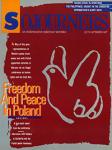Yippee! It's another bicentennial, if your constitution can stand it. As everyone within reach of American TV has no doubt noticed, it was 200 years ago that 55 rich white men closeted themselves away in Philadelphia to devise our form of government.
In the course of the year, their work has been commemorated with rallies, parties, fireworks, and a rich array of merchandising scams. On the more serious side, there have been TV capsule reports reliving each day of the Constitutional Convention, documentaries on the evolution of the document, and an endless stream of journalistic head-scratching and throat-clearing about, ahem, "what-it-all-means." Some have even noted that the 200-year-old fight over the balance of power between the executive and legislative branches was refought this summer in the Iran- contra hearings.
Meanwhile, the third branch of government has supplied a convenient constitutional news peg in the person of Supreme Court nominee Robert Bork. Bork is, of course, among those who ascribe immutable, metaphysical truth to the original manuscript of the Constitution and the inspired intent of its framers. In most cases this barely secularized version of the inerrancy doctrine seems also to enshrine the rather odd views of those 18th-century aristocrats regarding blacks, women, and men without property.
Of course the ultimate Constitution story this year came from Philadelphia itself, where federal and local police undertook to infiltrate and monitor several groups who planned to exercise their rights to freedom of speech and assembly at a public bicentennial affair. On May 25, at the Independence Mall celebration of the convention's opening, National Park
Service police prevented anyone with protest signs or buttons from entering the square. In a subsequent lawsuit, the citizens groups charged that one woman, not part of an organized demonstration, was denied entry to the mall for wearing a "Free South Africa" button. The cop allegedly told her that only "Reagan people," or those without any signs or buttons, could assemble there.
A lawyer for the protesters called this "a case dripping with irony." It is that. But in a perverse sort of way, it's also an appropriate commemoration of the events of 1787.
Freedom of expression was not exactly foremost on the minds of the constitutional framers that summer. Contrary to much popular hoopla, the Bill of Rights wasn't part of the document they authored. To get the popular votes needed for ratification, constitutional proponents were forced to promise that a Bill of Rights would be enacted by the first Congress.
In fact, subduing the people's impulse toward democratic expression was higher in the framers' priorities. Here, for relief from the "World According to Exxon" view of history, we must turn to Howard Zinn's indispensable book A People's History of the United States (Harper & Row, 1980). As Zinn reminds us, the impetus for a constitution came almost exclusively from the wealthy classes—bankers, traders, manufacturers, and slaveholders. These patriotic stalwarts felt the need for a strong central government to protect their interests from the rabble of peasants and debtors.
FROM INDEPENDENCE TO 1787, America was ruled under the Articles of Confederation, which left most significant powers to the several states. The central government was incapable of levying taxes or tariffs, enforcing the return of runaway slaves, or suppressing revolts by slaves or impoverished farmers. According to Zinn, "By 1787 there was not only a positive need for strong central government to protect the
large economic interests, but also immediate fear of rebellion by discontented farmers. The chief event causing this fear was an uprising in the summer of 1786 in western Massachusetts known as Shays' Rebellion."
In the course of that uprising, named for its leader Daniel Shays, hundreds of farmers, most of them veterans of the Revolutionary War, took up arms to prevent the courts from seizing the property of debtors. They overwhelmed local militias, many of whose members deserted to the farmers' cause. The revolt spread into scattered battles between farmers and the militias that went on well into the winter of 1786. Finally, Boston business interests raised money for a private army to suppress the uprising.
Thomas Jefferson, who was away as ambassador to Paris during this period, wrote of Shays' Rebellion, "I hold it that a little rebellion now and then is a good thing....a medicine necessary for the sound health of government." But his fellow Virginian James Madison was not so sympathetic. In The Federalist Papers, Madison argued for the proposed constitution's strong central government as insurance against a "rage for paper money, for an abolition of debts, for an equal division of property, or for any other improper or wicked project." Elsewhere in the Papers, Madison argued for the virtue of a single republic spread over a huge geographic area, saying that in "an extensive republic it will be more difficult for all who feel it to discover their own strength, and to act in unison with each other."
As best as I can tell, the bicentennial of Shays' Rebellion went uncommemorated. But it's never too late for good Americans to discover their own strength and act in unison with each other for a more equal division of property and other such "wicked" projects.
Danny Duncan Collum is a Sojourners contributing editor.

Got something to say about what you're reading? We value your feedback!
